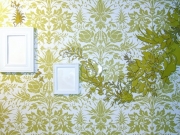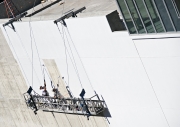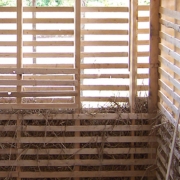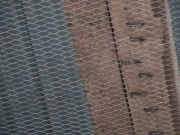- Error
{Re}habitat
Learn how adaptive reuse and upcycling can add hip design to your home, apartment, or yard with the Go Green channel's {Re}habitat series. Follow host Rachael Ranney as she shows you how to repurpose salvaged and found materials, adding fun and function to your space without breaking your budget.

Resilient flooring refers to a type of material that has "give" as weight compresses its surface, and "return" (to its original surface profile) after the weight has been removed. Common types of resilient flooring are made from materials like rubber, linoleum, cork, asphalt, and vinyl.
Terrazzo, derived from the Italian word "terrace," is thought to have been first put to use in 15th century Venice. A vast amount of terrazzo remains in Italy's ancient architecture from this time period, supporting this assumption; however, archaeologists have also discovered the use of a matrix and marble chip flooring system used in Turkey that may be as much as 10,000 years old. Italian craftsmen historically used discarded marble chips to create floors on exterior terraces around their homes. The marble chips were embedded in clay, and when the clay dried, the surface of the flooring was ground down, making it smooth and durable.
Wallpaper is a decorative wall covering used in both residential and commercial spaces. It can be applied full height or used as a wainscot, border or decal. Wallpaper was invented by the Chinese, who applied rice paper to walls as early as 200 B.C. Since that time, several cultures (including the Chinese, Arabs, French, English and Americans) have contributed to the improvement of wallpaper through material developments. Today's wallpaper is a technologically advanced product that is available in a variety of materials, types, styles, and patterns. It is relatively easy to install and is very durable.
Painting was originally a method of representing, documenting, or expressing the varied interests, subjects and beliefs that were a part of society. Paint as a material or method of decorating buildings did not become popular until the 19th century. Master builders and architects of the day used more permanent materials, such as carved stone or marble, colorful ceramic tiles, or pigmented stucco and plaster to develop their designs and decorate the exteriors of buildings.
Around the world, plaster has been a mainstay of construction for thousands of years. Problems with old plaster vary according to a building's historical time period and the type of construction. With some basic tools, and by incorporating common materials along with today's technology, plaster restoration solutions present themselves.
Plaster assemblies include traditional three coat systems over wood, metal, or rock lath, as well as more recent plaster systems such as veneer plasters.
Plaster in a traditional three coat system is unmatched in its strength and durability. This system is also fire resistive and can reduce sound transmission. Plaster must be applied in such a way that it adheres to the support surface; the support surface, in turn, must be strong enough to carry the weight of the plaster. In the past, applying a plaster coating over a stone or masonry wall seemed to satisfy the strength and texture requirements. However, when framed construction became popular, interior walls lacked both. To solve this problem, thin strips of wood called lath were applied perpendicular to the framing. This solution both strengthened the wall and created a uniform surface to which the plaster could adhere.
Lath provides a means of holding plaster in place. Typically, three types of lath can be found throughout North America: wood lath, metal lath, and rock lath.
Quarry tile is a common type of floor finish material that is an unglazed blend of natural clays. Differing from ceramic tile, quarry tile is extruded to create a very dense product.



